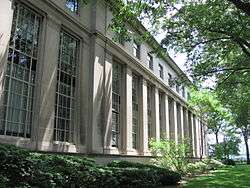Massachusetts Institute of Technology School of Engineering
The MIT School of Engineering (SoE) is one of the five schools of the Massachusetts Institute of Technology, located in Cambridge, Massachusetts, United States. SoE has eight academic departments and two interdisciplinary institutes. The School grants SB, MEng, SM, engineer's degrees, and PhD or ScD degrees. As of 2019, the Dean of Engineering is Professor Ian Waitz. The school is the largest at MIT as measured by undergraduate and graduate enrollments and faculty members.[1]

Pierce Engineering Laboratory
Departments and initiatives
- Aeronautics and Astronautics
- Biological Engineering
- Chemical Engineering
- Civil and Environmental Engineering
- Electrical Engineering and Computer Science
- Institute for Data, Systems, and Society
- Institute for Medical Engineering and Science
- Materials Science and Engineering
- Mechanical Engineering
- Nuclear Science and Engineering
- Computer Software Engineering
Laboratories and research centers
- Abdul Latif Jameel Water and Food Systems Lab
- Center for Advanced Nuclear Energy Systems
- Center for Computational Engineering
- Center for Materials Science and Engineering
- Center for Ocean Engineering
- Center for Transportation and Logistics
- Computer Science and Artificial Intelligence Laboratory
- Industrial Performance Center
- Institute for Soldier Nanotechnologies
- Koch Institute for Integrative Cancer Research
- Laboratory for Information and Decision Systems
- Laboratory for Manufacturing and Productivity
- Materials Processing Center
- Microsystems Technology Laboratories
- MIT Lincoln Laboratory Beaver Works Center
- Novartis-MIT Center for Continuous Manufacturing
- Ocean Engineering Design Laboratory
- Research Laboratory of Electronics
- SMART Center
- Sociotechnical Systems Research Center
- Tata Center for Technology and Design
Former MIT Deans of Engineering
- Vannevar Bush 1931-1938
- Edward Leyburn Moreland 1938-1946
- Thomas Kilgore Sherwood 1946-1952
- Edward Lull Cochrane 1952-1954
- Carl Richard Söderberg 1954-1959
- Gordon Stanley Brown 1959-1968
- Raymond Lewis Bisplinghoff 1968-1971
- Alfred H. Keil 1971-1977
- James D. Bruce 1977-1978 (Acting Dean)
- Robert Seamans 1978-1981
- Gerald L. Wilson 1981-1991
- Joel Moses 1991-1995
- Robert A. Brown 1996-1999
- Thomas L. Magnanti 1999-2007
- Subra Suresh 2007-2009
- Cynthia Barnhart 2009–2011 (Acting Dean)
gollark: Wouldn't the real problem be updating them all?
gollark: It's clear that the solution is a generalized programming language for describing group relations and automatically putting things into groups.Seriously, though, how would nested groups help?
gollark: In my opinion the best way would be to allow set operators on groups to form other groups, but you know.
gollark: When TJ09 wills it.
gollark: Now I can influence stuff or whatever!
References
- "MIT School of Engineering: About". MIT. Retrieved August 13, 2007.
External links
- MIT School of Engineering website
- MIT Learning International Networks Consortium
- MIT School of Engineering Dean's Advisory Council (DAC)
This article is issued from Wikipedia. The text is licensed under Creative Commons - Attribution - Sharealike. Additional terms may apply for the media files.